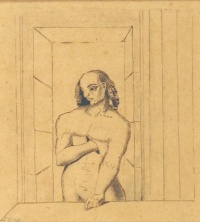Interpersonal relationship
From The Art and Popular Culture Encyclopedia
| Revision as of 21:46, 5 January 2014 Jahsonic (Talk | contribs) ← Previous diff |
Revision as of 07:56, 1 June 2014 Jahsonic (Talk | contribs) Next diff → |
||
| Line 3: | Line 3: | ||
| <small>Illustration: ''[[The Heart Has Its Reasons]]'' (c.1887) by [[Odilon Redon]]</small> | <small>Illustration: ''[[The Heart Has Its Reasons]]'' (c.1887) by [[Odilon Redon]]</small> | ||
| <hr> | <hr> | ||
| - | What makes us like new acquaintances is not so much any weariness of our old ones, or the pleasure of change, as disgust at not being sufficiently admired by those who know us too well, and the hope of being more so by those who do not know so much of us. --''[[Reflections; or Sentences and Moral Maxims]]'', [[François de La Rochefoucauld]]. | + | What makes us like new acquaintances is not so much any weariness of our old ones, or the pleasure of change, as disgust at not being sufficiently admired by those who know us too well, and the hope of being more so by those who do not know so much of us. --''[[Reflections; or Sentences and Moral Maxims]]'', [[François de La Rochefoucauld]].]] |
| - | + | ||
| - | ]] | + | |
| [[Image:Bouguereau Innocence.jpg|thumb|200px|[[Innocence]] ([[1893]]) by [[William-Adolphe Bouguereau]]: Both young [[children]] and [[lamb]]s are symbols of innocence]] | [[Image:Bouguereau Innocence.jpg|thumb|200px|[[Innocence]] ([[1893]]) by [[William-Adolphe Bouguereau]]: Both young [[children]] and [[lamb]]s are symbols of innocence]] | ||
| [[Image:Fashionable contrasts James Gillray.jpg |thumb|right|200px|''[[Fashionable Contrasts]]'' ([[1792]]) by [[James Gillray]] | [[Image:Fashionable contrasts James Gillray.jpg |thumb|right|200px|''[[Fashionable Contrasts]]'' ([[1792]]) by [[James Gillray]] | ||
Revision as of 07:56, 1 June 2014

Illustration: The Heart Has Its Reasons (c.1887) by Odilon Redon
What makes us like new acquaintances is not so much any weariness of our old ones, or the pleasure of change, as disgust at not being sufficiently admired by those who know us too well, and the hope of being more so by those who do not know so much of us. --Reflections; or Sentences and Moral Maxims, François de La Rochefoucauld.


Interpersonal relationship is part of the interpersonal relations portal
|
Related e |
|
Featured: |
Interpersonal relationships are social associations, connections, or affiliations between two or more people who may interact overtly, covertly, face to face or may remain effectively unknown to each other such as those in a virtual community who maintain anonymity and do not socialize outside of a chat room.
The interactions that define an interpersonal relationship can be observable and explicit such as body language or dialogue. Or they can be implicit such as standing in a shopping line or in an emergency room. They are usually a mixture of both. An interpersonal interaction can constitute a social transaction such as the form, 'you scratch my back, I'll scratch yours'. Some transactions facilitate further interaction between the participants and some are show stoppers. Interpersonal violence is action, interaction and transaction, which doesn't always terminate the relationship.
Context is everything when it comes to meaningfully describing a particular interaction between people. Meaning itself results from interpersonal interactions, most significantly in the developmental stage of life with peers, parents and teachers. Culture is transmitted by socialization. Culture forms how we construct our world and the relationships in it.
They vary in the degree to which intimacy and sharing occur - implying the discovery or establishment of common ground, are present. They may or may not be centered around something(s) shared in common.
See also
- Affection
- Attachment theory
- Courtship
- Empathy
- Friendship
- Human bonding
- Interpersonal attraction
- Interpersonal communication
- Interpersonal compatibility
- Intimate relationship
- Jointness (psychodynamics)
- Love
- People skills
- Social interaction
- Social rejection
- Sympathy
- Theology of relational care

